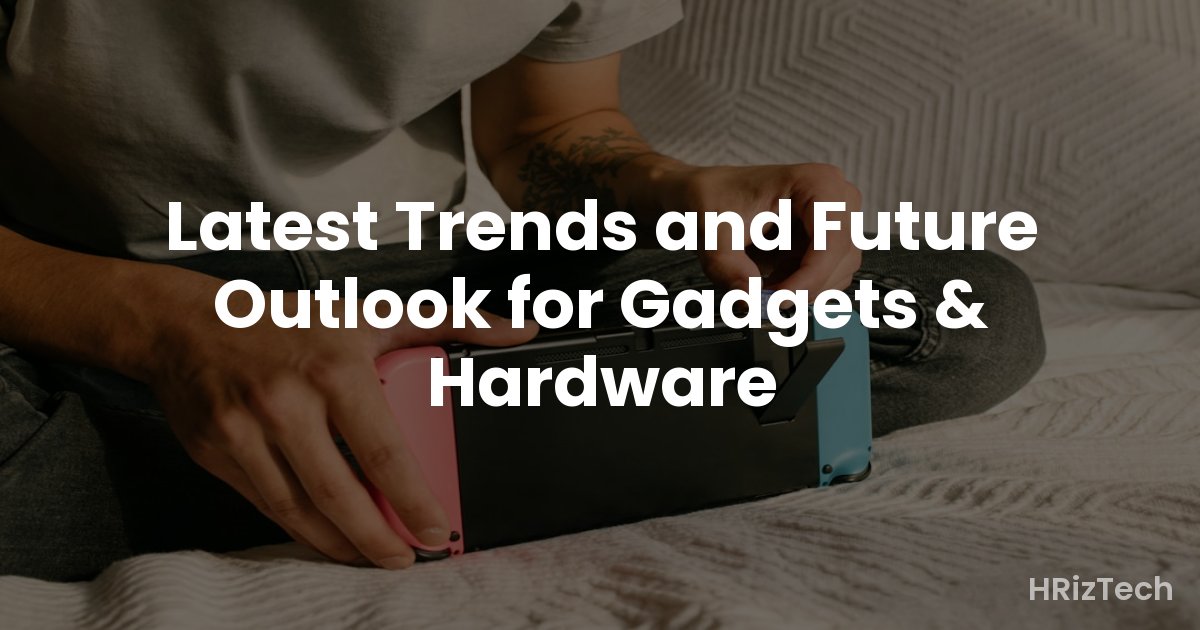Latest Trends and Future Outlook for Gadgets & Hardware

Latest Trends and Future Outlook for Gadgets & Hardware
- AI integration is becoming ubiquitous across all gadget categories.
- Sustainability is a driving force in materials and manufacturing.
- Foldable and flexible displays are gaining mainstream adoption.
- The metaverse is impacting hardware design and functionality.
- Expect increased focus on user privacy and data security.
The Rise of AI-Powered Gadgets
Artificial intelligence is no longer a futuristic concept; it's rapidly becoming integrated into our everyday gadgets. Smartphones, smart speakers, and even appliances are leveraging AI for enhanced functionality and personalized experiences. From sophisticated voice assistants capable of complex tasks to predictive maintenance in smart home devices, AI is streamlining our lives and improving efficiency. This trend is set to accelerate, with AI becoming even more sophisticated and integrated into the very fabric of our technological landscape. We can expect to see AI-powered features becoming more seamless and intuitive, requiring less user intervention and offering more proactive support.
AI in Smartphones and Wearables
Smartphones are at the forefront of AI integration. Advanced image processing, real-time translation, and intelligent personal assistants are now commonplace. Wearable technology is also embracing AI, with smartwatches and fitness trackers utilizing AI to monitor health metrics, provide personalized workout recommendations, and even detect potential health issues. The future will likely see even more sophisticated health monitoring capabilities, personalized medicine insights, and seamless integration with other AI-powered devices and services.
Sustainability Takes Center Stage
Growing environmental concerns are pushing the tech industry towards more sustainable practices. Manufacturers are increasingly focusing on using recycled materials, reducing energy consumption, and extending the lifespan of their products. This commitment to sustainability is not just a trend; it's a necessity driven by both consumer demand and regulatory pressure. We can expect to see more eco-friendly packaging, longer product warranties, and initiatives aimed at reducing electronic waste.
Sustainable Manufacturing and Materials
The search for sustainable materials is driving innovation in the tech industry. Companies are exploring the use of recycled plastics, biodegradable components, and renewable energy sources in their manufacturing processes. This shift towards sustainability is not only environmentally beneficial but also economically advantageous, as consumers are increasingly willing to pay a premium for eco-friendly products. This trend will continue to gain momentum, with greater transparency and accountability regarding the environmental impact of gadgets and hardware.
The Foldable Revolution
Foldable and flexible displays are no longer a niche market; they're gradually entering the mainstream. While still relatively expensive, foldable smartphones and tablets are becoming more accessible and offer a unique user experience. The ability to seamlessly switch between different screen sizes enhances productivity and entertainment. This technology is expected to mature further, with more durable and affordable devices entering the market. The future may see foldable screens integrated into a wider range of devices, including laptops and even larger displays.
The Metaverse and Its Hardware Implications
The metaverse is shaping the future of gadgets and hardware in significant ways. The demand for immersive experiences is driving innovation in virtual reality (VR) and augmented reality (AR) headsets, haptic feedback devices, and other peripherals. These advancements are not only enhancing gaming and entertainment but also transforming fields such as education, healthcare, and design. We can anticipate a greater convergence of VR/AR technologies, with more seamless integration between the physical and digital worlds.
Hardware for Immersive Experiences
The metaverse requires specialized hardware to deliver truly immersive experiences. This includes high-resolution displays, advanced sensors, and powerful processors. The development of lighter, more comfortable, and more affordable VR/AR headsets will be crucial for mainstream adoption. Haptic feedback technology will also play a vital role, providing users with a more realistic sense of touch and presence in the virtual environment.
Privacy and Security: A Growing Concern
With the increasing connectivity of our devices, privacy and security are paramount. Consumers are becoming more aware of the data collected by their gadgets and demanding greater control over their personal information. Manufacturers are responding by implementing stronger security measures, such as end-to-end encryption and enhanced biometric authentication. This trend will continue to drive innovation in privacy-enhancing technologies, with a greater emphasis on data minimization and user consent.
PHP Code Example: Simple Data Logging
PHP Code Example: Basic Data Analysis
Conclusion
The future of gadgets and hardware is dynamic and exciting, driven by advancements in AI, sustainability, and immersive technologies. As consumers become increasingly discerning, manufacturers will need to prioritize both functionality and ethical considerations. The convergence of these trends promises a future where technology seamlessly integrates into our lives, improving efficiency, enhancing experiences, and promoting sustainability.What emerging technology are you most excited about in the gadget and hardware space?
Comments
No comments yet. Be the first to comment!